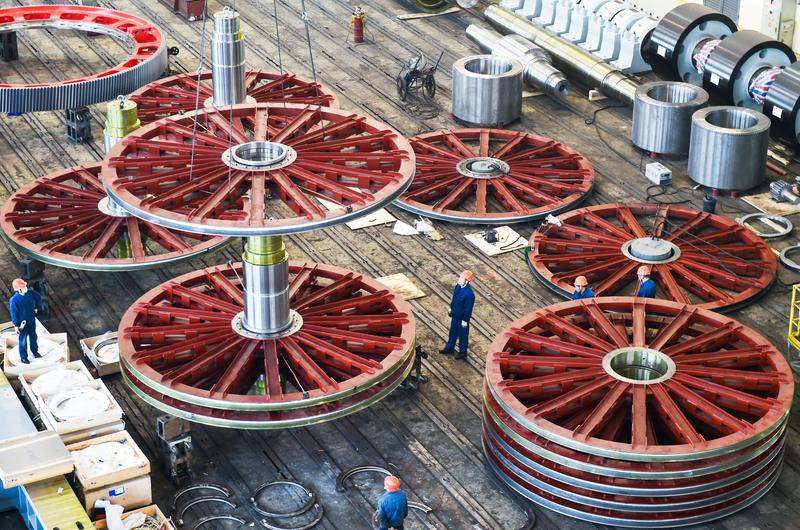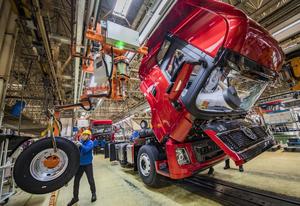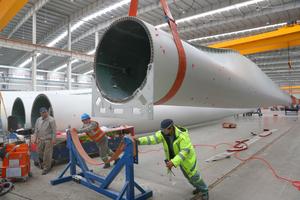Editor's Note: During this year's two sessions-the annual meetings of the National People's Congress and the National Committee of the Chinese People's Political Consultative Conference-China Daily is publishing a series of stories focusing on the achievements the country made in various fields during the 13th Five-Year Plan (2016-20). They show how the country met its development goals in different fields in the face of numerous challenges.
 Workers assemble a shaft hoist at CITIC Heavy Industries' plant in Luoyang, Henan province, on Jan 27. (HUANG ZHENGWEI / FOR CHINA DAILY)
Workers assemble a shaft hoist at CITIC Heavy Industries' plant in Luoyang, Henan province, on Jan 27. (HUANG ZHENGWEI / FOR CHINA DAILY)
China's intensified efforts to speed up the establishment of a modern industrial system over the next five years demonstrate its resolve to pursue high-quality growth and innovation-driven development, officials and experts said.
The country has pledged to further develop the real economy, strengthen industrial and supply chains, boost industrial upgrading and foster high-quality manufacturing, according to the draft outline of the 14th Five-Year Plan for National Economic and Social Development and Long-Range Objectives Through the Year 2035.
This year, the first of the planning period, China has vowed to accelerate industrial transformation and upgrades, Premier Li Keqiang said on Friday when delivering the 2021 Government Work Report at the opening of the fourth session of the 13th National People's Congress.
We need to work harder to enhance technological innovation and emergency responses, speed up breakthroughs on key technologies and build an efficient system of technological innovation and transfers.
Zhang Yuxian, director of the Department of Economic Forecasting at the State Information Center
Measures to stabilize industrial and supply chains to make them more self-supporting will be sped up. More efforts will also be made to develop the industrial internet by accelerating the development of 5G networks and 1000M fiber optic networks, the report said.
Spurring the development of strategic emerging industries, strengthening China's quality infrastructure and championing the pursuit of fine workmanship will boost the quality of manufacturing, according to the work report.
Zhang Yuxian, director of the Department of Economic Forecasting at the State Information Center, said China has the confidence and capabilities to meet the targets in the next five years, as it has a complete industrial system, a large number of skilled workers and engineers, developed infrastructure and logistics networks, and a very large domestic market.
Citing official data, Zhang said China has 41 major industrial categories, 191 medium categories, and 525 subcategories, making it the only country in the world that has all the industrial categories in the United Nations industrial classification system.
During the 13th Five-Year Plan (2016-20), China made considerable progress in boosting the development of the manufacturing sector.
According to data from the Ministry of Industry and Information Technology, the average growth rate of added value of the high-tech manufacturing industry was 10.4 percent from 2016 to last year, which was 4.9 percentage points higher than the average growth rate of added value of industrial companies with annual revenue of more than 20 million yuan (US$3.06 million) for the same period.
The added value of the information transmission, software and information technology service industries more than doubled from about 1.8 trillion yuan in 2016 to 3.8 trillion yuan last year.
 Trucks on an assembly line at the Shaanxi Heavy Duty Automobile plant in Xi'an, Shaanxi province, on Jan 4. (YUAN JINGZHI / FOR CHINA DAILY)
Trucks on an assembly line at the Shaanxi Heavy Duty Automobile plant in Xi'an, Shaanxi province, on Jan 4. (YUAN JINGZHI / FOR CHINA DAILY)
Zhang also warned of challenges ahead, saying more efforts should be made to stabilize and strengthen industrial and supply chains. "We've seen an acceleration in the movement of some manufacturing plants from China to overseas because of the rising costs," Zhang said. "China's capacity for independent innovation is still weak, and its industrial chain as a whole is still at the middle to low end of the global value chain."
There are also mounting uncertainties and risks amid the push against globalization as well as rising protectionism and unilateralism from some countries, he said.
To remove hindrances to industrial upgrading and development amid the complicated international situation and COVID-19 pandemic, Zhang said its foundations need to be consolidated and weak links strengthened.
"We need to work harder to enhance technological innovation and emergency responses, speed up breakthroughs on key technologies and build an efficient system of technological innovation and transfers," Zhang said.
More efforts are also needed to accelerate industrial transfers to central and western regions of the country, promote the integration of industrial and innovation chains, spur the development of the digital economy and develop smart and digital industrial chains. Greater focus is also needed to supporting the development of key fields including core components, high-end chips and basic software, Zhang said.
 Wind turbine blades are manufactured at a plant in Nantong, Jiangsu province, on March 2. (XU CONGJUN / FOR CHINA DAILY)
Wind turbine blades are manufactured at a plant in Nantong, Jiangsu province, on March 2. (XU CONGJUN / FOR CHINA DAILY)
Balancing interests
Experts said it is important for China to balance self-sufficiency in key technologies with international cooperation, as it builds a modern industrial system over the next five years.
Jiang Xiaojuan, head of the School of Public Policy and Management at Tsinghua University, said improving fundamental industrial capabilities and removing technological bottlenecks are crucial to achieve high-quality growth under the dual circulation development strategy.
In the past, when globalization was in a strong development phase, active involvement in trade played an important role in boosting China's economic growth. But in recent years, international economic circulation has significantly weakened, said Jiang, a former deputy secretary-general of the State Council, China's Cabinet.
Meanwhile, China has emerged as the world's second-largest economy, with a complete industrial system and very large domestic market. "Such a large economy can't be simply driven by the international market. Taking the domestic market as the mainstay is not only a strategic plan, but also a realistic requirement," she said.
ALSO READ: Top leaders urge self-reliance in science, defense
Jiang Xiaojuan, head of the School of Public Policy and Management at Tsinghua University, said improving fundamental industrial capabilities and removing technological bottlenecks are crucial to achieve high-quality growth under the dual circulation development strategy
However, the push to promote internal economic circulation and pursue self-sufficiency in some crucial technologies does not mean an isolationist strategy.
Instead, deeper global cooperation and higher-level participation in international circulation is required, experts added.
Qiao Biao, deputy head of the China Center for Information Industry Development, a think tank in Beijing, said that like the rest of the world, China is working hard to strike a balance between technological independence and international cooperation.
The nation's industrial output reached 31.31 trillion yuan last year, making it the world's largest manufacturing country for 11 consecutive years, according to MIIT data.
But challenges exist as China relies on imports of key technologies such as components used in robotics. "China's plan to seek self-reliance in certain crucial technologies came amid bans on the export of such technologies to the country," Qiao said.
"We have no choice but to work hard to crack hard nuts, such as bottlenecks in technological advancement, to meet our own demands. We are pursuing self-reliance in very limited areas. When it comes to most technological products and services, we have a very strong commitment to international cooperation."
Chinese companies are also working to strengthen international cooperation while sharpening their own technological advantages.

Ren Zhengfei, founder of Huawei Technologies, said despite Huawei suffering from Washington's restrictions on access to United States' technologies, his company remains a staunch supporter of globalization. "Deepening international cooperation and beefing up our own research and development at the same time are the keys to helping us survive the current difficulties," Ren said.
Joint global efforts are needed to crack new business frontiers as an individual company may not have the knowledge to take the right direction, he said.
Yang Yuanqing, chairman and CEO of Lenovo, the world's largest personal computer maker, said international cooperation remains one of the keys to ensuring the efficiency and healthy development of supply chains around the world.
READ MORE: PC giant Lenovo striving to cut ecological impact
"China has the world's largest manufacturing system with the most complete industrial chain and supporting facilities," Yang said. "The nation is undergoing a critical stage of moving from a manufacturing powerhouse to a smart-manufacturing center, which will generate more opportunities."


